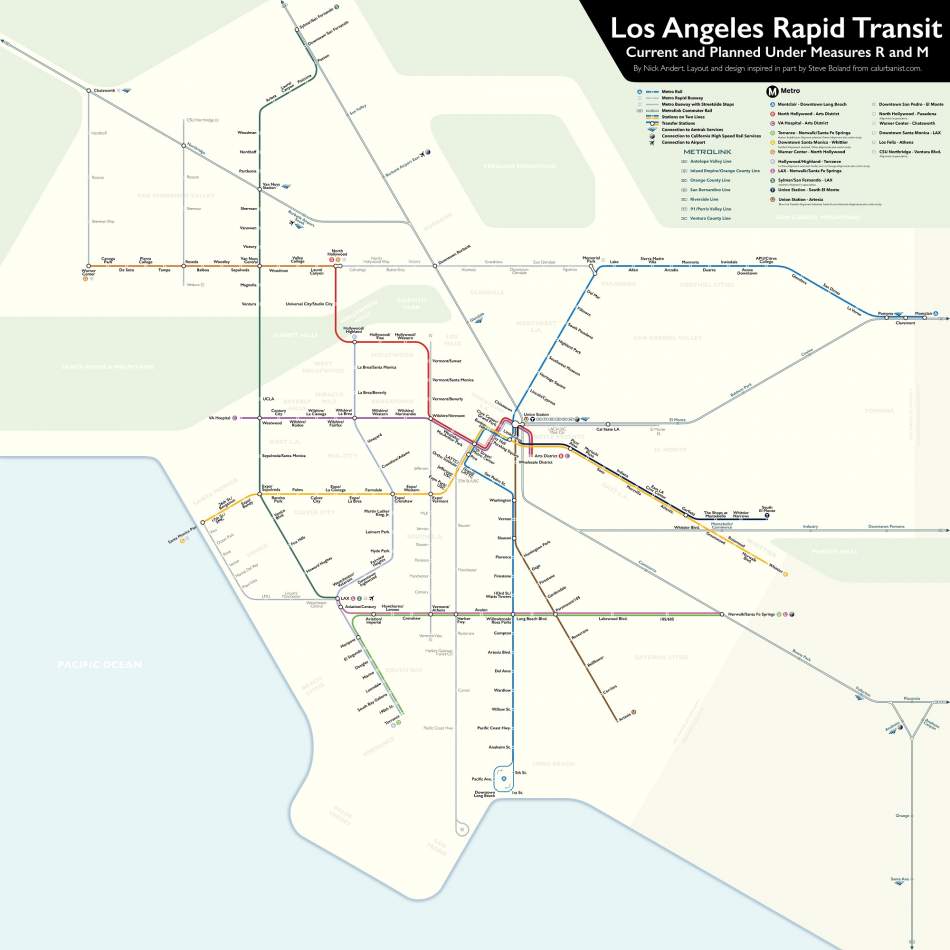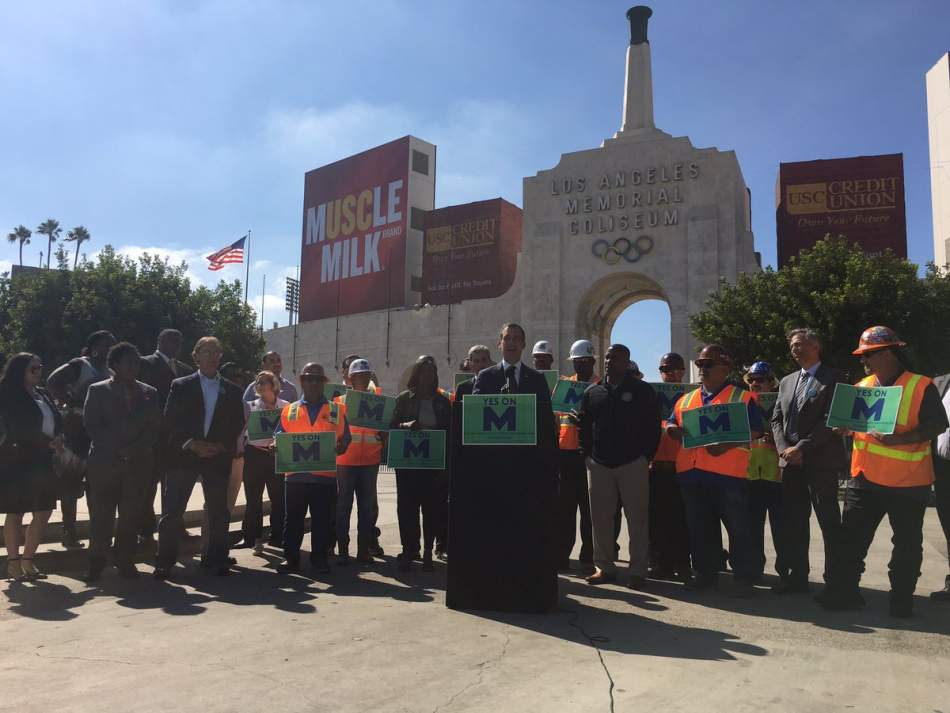For most of the year, it was uncertain whether or not Measure M would pass. It is difficult to meet the required two-thirds margin of approval even under the best circumstances, and several factors were perceived as jeopardizing Measure M’s chances. Prominent among those issues were the county’s already-high taxes, transit ridership that had not increased along with investments, and a roster of cities and COGs that were staunchly opposed Metro’s “forever” tax. As late as two weeks before election day, Yonah Freemark, keeping tabs on local transit taxes throughout the U.S., predicted that L.A.’s would fail.

Instead, Measure M began the night above the two-thirds threshold and steadily rose in the ensuing weeks. The vote would eventually be certified at 71.15% in approval. So, at the December 1st meeting of the Metro Board of Directors – the first since the election, and the last until 2017 – when CEO Phil Washington reported on the status of the vote tally, he had every reason to be in a celebratory mood. Angelenos had voiced their willingness to tax themselves to improve their region. The margin of support, as Washington put it, constituted a “mandate” for Metro.
It’s hard to deny the impressiveness of Metro’s victory here. For 7 in 10 voters to agree on anything is rare, and only more so when that thing is a tax increase. At first glance, there’s every reason to believe there should be some underlying message from voters to politicians. But parsing the will of the electorate is delicate work. Depending on what audience you sat in this year, you might have heard Measure M described as a jobs program, a maintenance fund for the county’s failing infrastructure, the country’s most aggressive transit expansion program, an investment opportunity for private business, a subsidy intended to keep discounted fares low, local dollars to fund street paving and sidewalk repair, or maybe it was for bus service, or adding bike lanes, or to widen freeways. The unifying theme was that Measure M would Get You Out Of Traffic, and the possible mandates all revolve around that idea.
The Transit Mandate
The first thing advocates of better transit in Los Angeles will look for is a mandate for public transportation, its construction, maintenance, and most of all usage. This unfortunately is not borne out by the facts of the ballot measure. While it is true that the majority of the money does go to funding transit-related activities, it is significant that money is still being provided for freeway expansions. The political realities of passing a local sales tax in Los Angeles suggest that some highway funding may have been unavoidable. Nonetheless, those projects will be deleterious in the long-term to transit usage in the county. Measure M will not be used to fund the grade-separated 710 highway project. It will, however, be used to fund many freeway widenings throughout the county. It will, through local return dollars, be used to fund many road widening projects too. While induced demand will prevent them from functioning as desired (that is, from making traffic flow more freely), the excess capacity provided for has a very real effect on transit ridership. Each additional person added to the roads in a single occupancy vehicle is a person that is not taking transit.
And, after all, the run-up to November’s election prominently featured an ad campaign stating that Metro, in its capacity as a transit service provider, “eases” traffic. There is some reason to believe that Metro runs its transit network with exactly this goal in mind. If this is the fundamental goal, it might explain ending an all-day 6-minute frequency on the MTA’s newest rail line after just two months. It might explain cutting night rail frequencies in half to save a few million dollars annually. These service cuts take place outside peak hours, when there might not be any traffic that needs easing.
The sales tax did not promise minimum headway standards, or extended span of service, or even targets for ridership increases. It was sold on promises of reduction in travel time for single-occupancy vehicles. Further, Phil Washington has stated a desire to turn Los Angeles into the “infrastructure capitol of the world,” a general statement, which coming from Metro’s CEO seems to indicate an institutional understanding of rail expansion as a jobs program or economic development funding, rather than as the foundation upon which regional mobility should be built.
The Traffic-Easing Mandate
So let’s turn instead to auto traffic. L.A. traffic is like a belt sander for the soul, and millions of Angelenos are tired of strapping themselves to the sawhorse each day. They want to do something – anything – to free themselves from gridlock. But this is an old story. Transit expansions counterbalanced by freeway widenings is not indicative of a new multimodal Los Angeles, but rather of the status quo since the 1980s.

“Does Metro have a mandate to ease traffic?” is not a revealing question. They’ve had that mandate all along. The real question is “What can they do to achieve that aim?” Multimodality is a nice sentiment, but it is not achievable without a direct, stated focus on modal share, on increasing the percentage of Angelenos that choose transit, biking or walking over automobiles. All arguments deriving from “traffic-easing” will fail to accomplish this aim, because they are at root attempting to make driving more attractive, and in doing so will encourage people to continue to drive.
There are ways to encourage a future for Los Angeles that does not involve so much time wasted in traffic jams for so many. Some L.A. politicians are inclined to believe that that future is autonomous cars, a propping-up of the status quo by redefining wasted time as - in a limited way - productive time. Other alternatives necessarily involve significant shifts away from catering to space for cars, whether that is achieved through introducing maximum parking space allocations, taking driving lanes and turning them into protected bus and bike lanes, significantly increasing density throughout the Los Angeles basin, or a combination of such policies.
It is not quite true to say that Angelenos have shown they are willing to try anything. There are many things that Angelenos have not yet embraced. There has been no outpouring of support for massive increases in housing production in the city or county, or upzoning commercial corridors, or introducing more mixed-use neighborhoods outside of the urbanist petri dish of DTLA. Neither has there been a widespread reconsideration of the extreme commutes that are necessitated by our collective appetite for single-family homes. Los Angeles still wants unlimited mobility and a detached home in the suburbs. The city is considering a moratorium on new residential development in the hopes that this will somehow stop population growth and restrain ever-worsening traffic. Rather, if passed, it would have little impact on the former and rapidly exacerbate the latter.
The Garcetti Mandate
Garcetti was Measure M’s “most visible backer,” as KPCC put it. He was the face of ads depicting M as the alternative to freeway traffic, and, upon its passage, he too referred to the Measure M mandate.
In his case it might be more personal. The press was quick to note that Garcetti, believed to be politically risk-averse, had put considerable clout (and hundreds of thousands of dollars) on the line in the race to pass the transit tax. The mayor traveled beyond city limits to promote Measure M in all corners of the county. He has been known to remark that traffic doesn’t stop at the city’s boundaries and has embraced a role based more on regional cooperation than previous mayors.
Garcetti's charisma and dedication evidently paid off. His public stumping for the measure does not deserve all the credit for its passage, but it is still indicative of the trust and popularity he has beyond the city of Los Angeles. For instance, the ballot measure was condemned by the Mayor of Carson only to pass there with 75% of voters in approval. Voters could be said to have voiced confidence in Garcetti’s vision of Los Angeles County.
The Missing Mandate

Largely absent from discussions of Measure M was the environmental imperative to change the way that we move. Fond talk about autonomous cars serves only as a distraction from a basic understanding that sprawl is unsustainable. A Measure M campaign focused on greenhouse gas reduction and climate change would be concerned not only with spreading projects according to “geographic equity,” but also according to the quality of the corridor itself and its potential to provide the greatest benefit to the greatest number of transit riders. The MTA, operating under such a mandate, would treat the desire to live in sprawling suburbs as a lifestyle choice, rather than as the default. Choosing the suburbs is choosing car traffic, and the externalities of that choice are borne regionally. As such, congestion pricing - which would encourage alternatives to long commutes, reduce roadway congestion, and generate revenue - might be merited.
Displacement surrounding transit stations is a real issue, but it is one that arises from insufficient supply of housing surrounding transit stations. Maximizing transit ridership means maximizing access to the transit network. Access can mean building a 35-mile light rail line out to the county line, but it also can mean making it easier and more affordable to live in Central Los Angeles and on the Westside, by encouraging growth between these job and population centers and connecting them with all-day high-frequency rapid transit. Such a program would truly herald the beginning of a new period in Los Angeles’ history, but of course, there’s no mandate for it.
Scott Frazier is a graduate student at Cal State University Los Angeles in Public Administration. Follow him on Twitter @safrazie.
- Measure M Archive (Urbanize LA)








